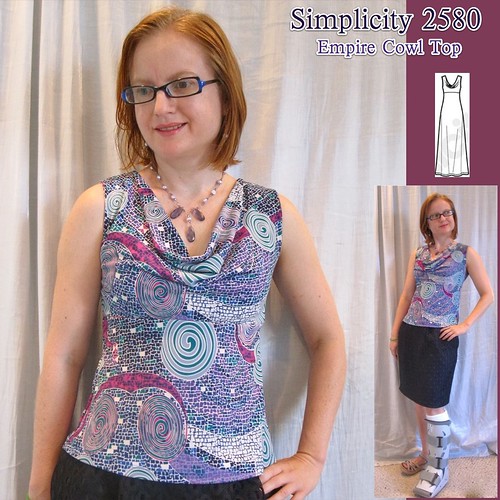
I buy just about every knit dress pattern that comes down the pike and am always looking at knit top patterns to see if they can be made into a dress. But it rarely occurs to me to turn a dress into a top. Melissa of Fehr Trade showed a cute cowl top made of the Simplicity 2580 and I tucked it into the back of my mind for the next time I had some odd-shaped scraps I couldn't do much else with.
I just got this fabric from Fabric Mart ($5.99/yd, pricey for me!) for my Turkey wardrobe and immediately sewed it into a long sleeve knit dress. The scraps were too big to throw away, but had to made into something pieced.
I am not crazy about empire waist tops lately, because they can be neither belted nor tucked and I have apparently turned into someone who wears a belt nearly every day. The tucking is more theoretical, but theoretically I am open to it. But I decided to throw caution to the wind and make it up in this pattern. I actually already made a top from this a while back; the fabric didn't have enough drape and it doesn't look great, but I knew it was a solid pattern and the fully self-faced cowl that will always sit perfectly and requires no rearranging sold me.
My one gripe is the instructions, which involve a lot of fussiness and inefficiency. Most cowl patterns these days seem to use the modern, all-machine-finish way; I was really impressed with the instructions for the McCall 6069 double cowl dress. So if you pull out one of your patterns it will probably do a much better job of explaining things than I am about to. What I love about this method is that you can do the whole thing with a twin needle in your sewing machine if you use a serger for construction. No switching back and forth between twin and regular.
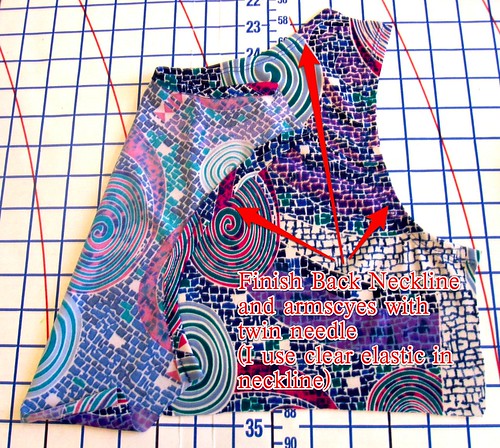 Start by finishing the neckline and armscyes of the back piece. For both, I just fold the seam allowance to the inside and twin needle in place. I fold the neckline over a piece of clear elastic slightly smaller than the length of the neckline to keep it in shape; the front cowl is heavy compared to the back so the back benefits from a little support. (If you're using a sleeve, obviously you don't need to finish the back armscye.)
Start by finishing the neckline and armscyes of the back piece. For both, I just fold the seam allowance to the inside and twin needle in place. I fold the neckline over a piece of clear elastic slightly smaller than the length of the neckline to keep it in shape; the front cowl is heavy compared to the back so the back benefits from a little support. (If you're using a sleeve, obviously you don't need to finish the back armscye.)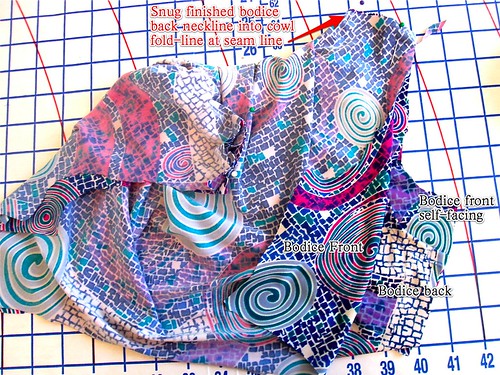 Next, fold the upper bodice and self facing along the fold line. Slip the back shoulder edge in between them. Snug the finished back neck to the fold line at the seamline. This is crucial. I am generally guilty of matching and pinning the edges rather than the seamlines, but here the you will have an unsightly bump if the back is not matched up to the fold at the seamline. Note that the unfinished edges of the front armscye will overhang the finished edge of the back armscye. Pin and serge.
Next, fold the upper bodice and self facing along the fold line. Slip the back shoulder edge in between them. Snug the finished back neck to the fold line at the seamline. This is crucial. I am generally guilty of matching and pinning the edges rather than the seamlines, but here the you will have an unsightly bump if the back is not matched up to the fold at the seamline. Note that the unfinished edges of the front armscye will overhang the finished edge of the back armscye. Pin and serge.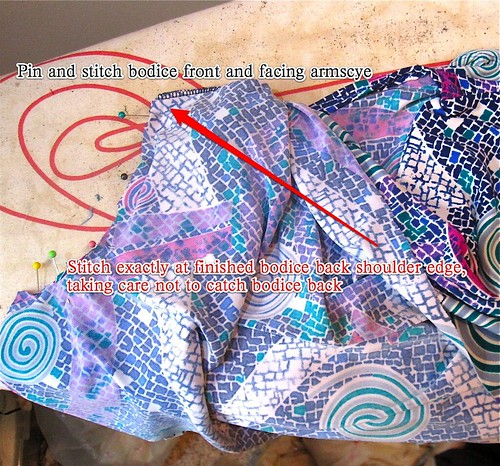 Now match up the edges of the front armscye outer fabric and self facing. Here it is important to mark exactly where the finished back armscye is hidden in between the two layers of the front (OK, fine, I admit it; I don't mark). Serge the front/self-facing armscyes, right sides together. At the shoulder edge, make sure your stitching line is exactly at the finished back armscye edge. Be careful not to catch the back into your seam (especially with a serger!).
Now match up the edges of the front armscye outer fabric and self facing. Here it is important to mark exactly where the finished back armscye is hidden in between the two layers of the front (OK, fine, I admit it; I don't mark). Serge the front/self-facing armscyes, right sides together. At the shoulder edge, make sure your stitching line is exactly at the finished back armscye edge. Be careful not to catch the back into your seam (especially with a serger!). When you turn it all right side out, you have your finished neckline and armscyes all done. If you've correctly matched everything up, the front and back will be seamless (well, not literally seamless but you know what I mean).
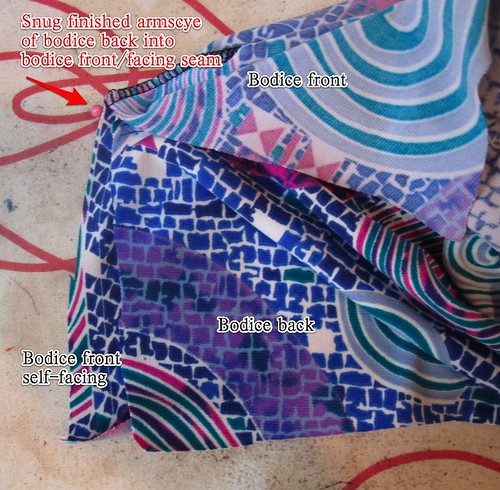 Next comes the side seam. As with the shoulder, you are going to sandwich the back between the front and front self-facing. This is a little easier because you just have to match up the raw edges. Again, it is important to snug the back finished armscye up into the front/self-facing serged together armscye at the seamline. Serge.
Next comes the side seam. As with the shoulder, you are going to sandwich the back between the front and front self-facing. This is a little easier because you just have to match up the raw edges. Again, it is important to snug the back finished armscye up into the front/self-facing serged together armscye at the seamline. Serge.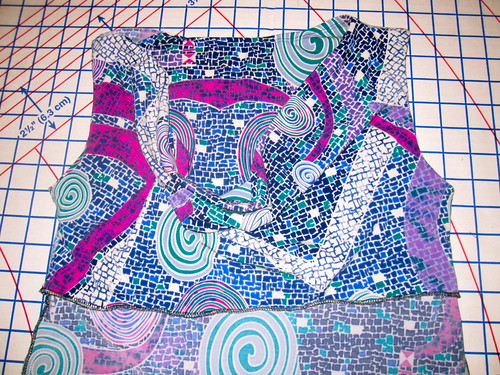 If you want to complete the clean finish, you can leave out the self facing when sewing the upper bodice and lower bodice and then hand-stitch the facing in place. However, a serged finish is good enough for me here.
If you want to complete the clean finish, you can leave out the self facing when sewing the upper bodice and lower bodice and then hand-stitch the facing in place. However, a serged finish is good enough for me here. Serge the side seams of the lower front and back and center seam of lower back. I used the center back seam in the lower bodice for some swayback shaping.
Treat the front and front self-facing as one and pin the upper bodice to the lower bodice. Serge.
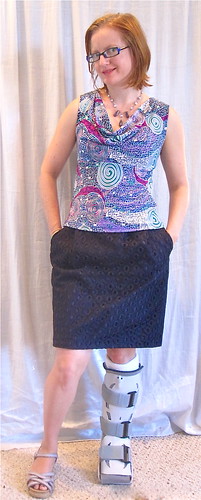 Your machine is still set up in a twin needle so you can easily hem the top and voila! A nicely finished cowl top with a minimum of effort.
Your machine is still set up in a twin needle so you can easily hem the top and voila! A nicely finished cowl top with a minimum of effort.I am really happy with the top, despite the empire waist. It's a fantastic way to wear my lace Burda 09-2008-108 skirt for summer and in a casual way. If I'd had enough fabric I would have liked to avoid that big circle that's almost at center front on the lower bodice but it was a top with a big circle at center front or no top at all.
All photos are here and the pattern review is here.
=======================
I am sewing like crazy for my Turkey trip! It's still a little too early to know exactly what the weather will be, so I have been making both long sleeve and short sleeve items. It seems to be tipping toward cool, though, low 60s (16-18 C for my metric readers). I can handle cool weather, I suppose, but it is also looking rainy. Much less fun for sightseeing. I will have to ponder whether it will be worth it to bring a pair of boots. They take up so much room, but shoes are really no good to be out in rain for 8-10 hours. I suppose much depends on my therapeutic boot situation. I go to the doctor this afternoon so keep your fingers crossed for me!
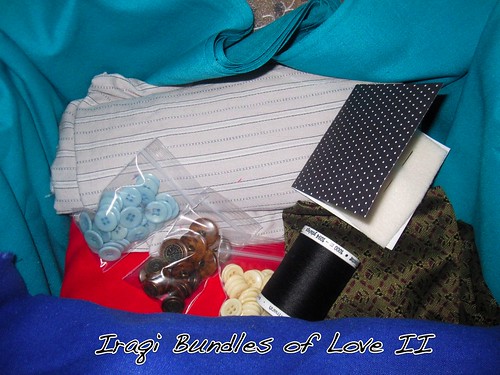
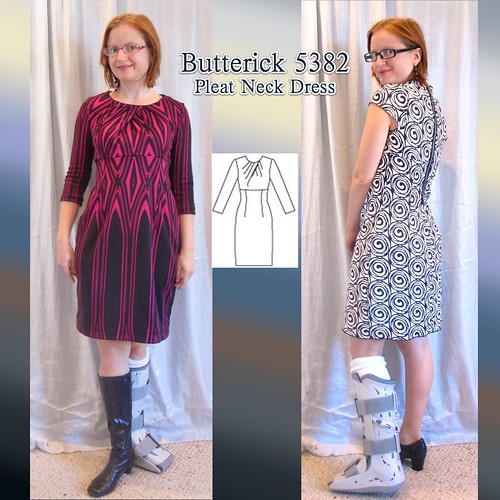
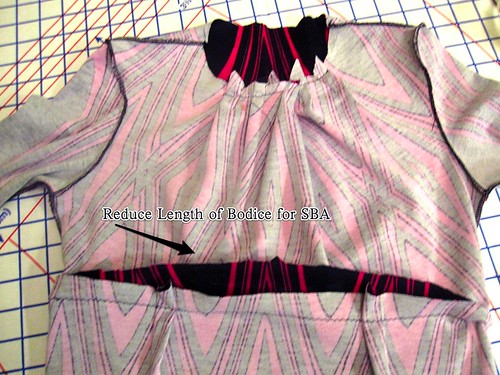

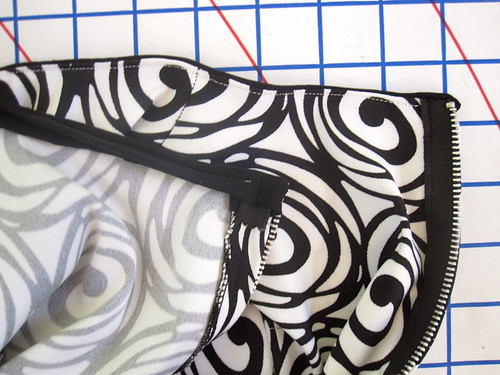
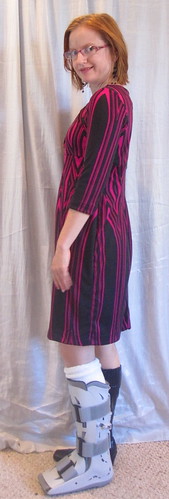

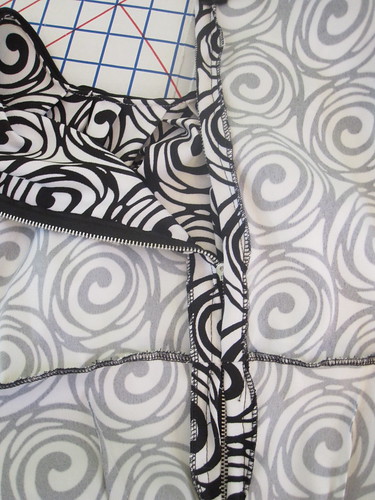
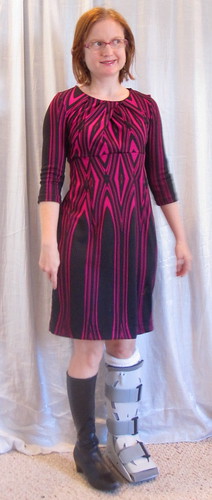
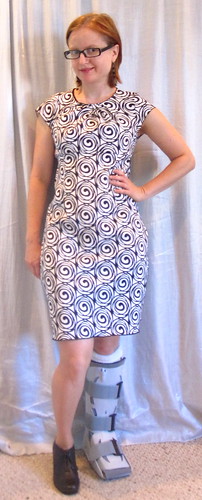
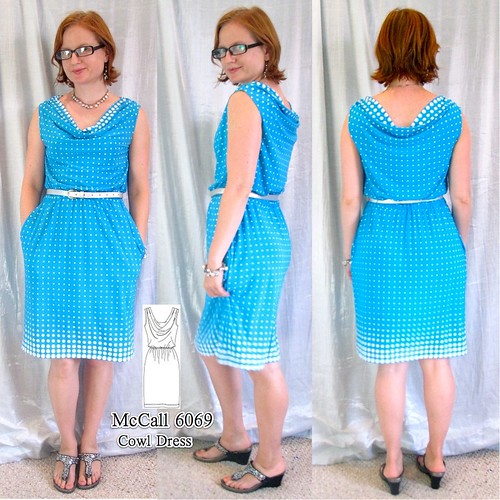
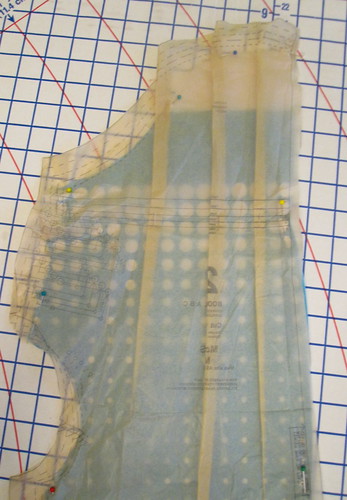
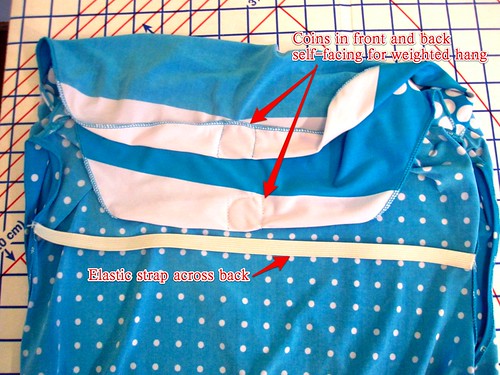
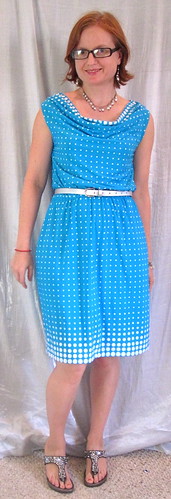
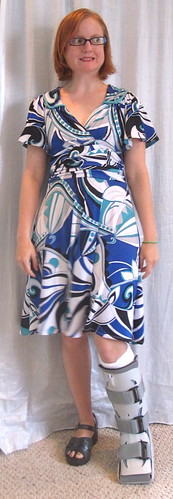
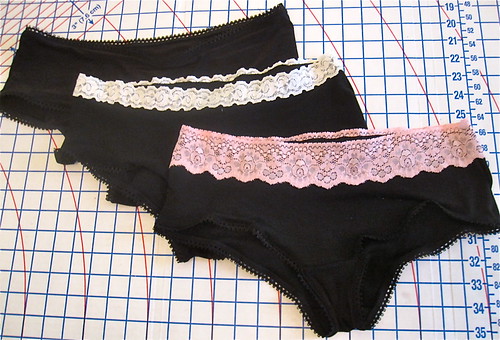
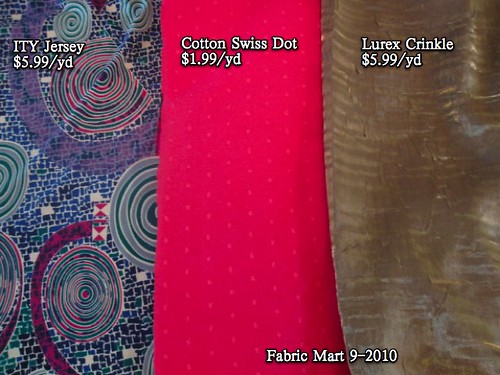


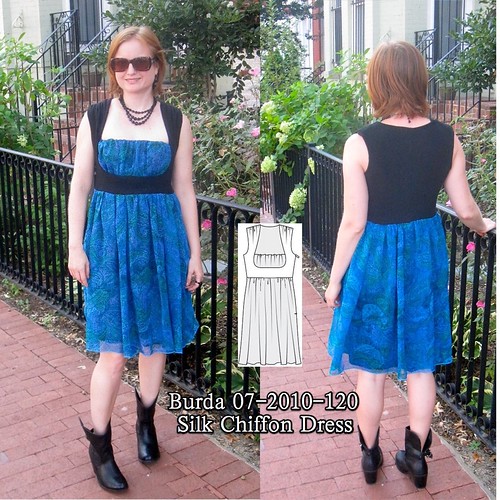
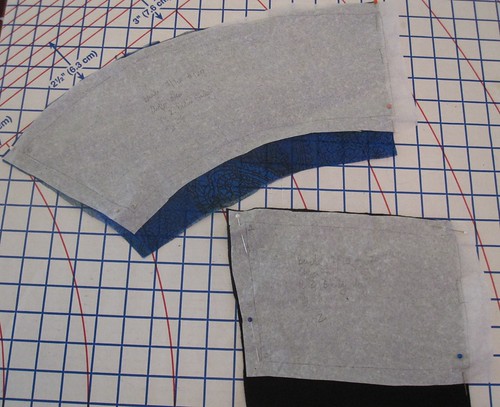
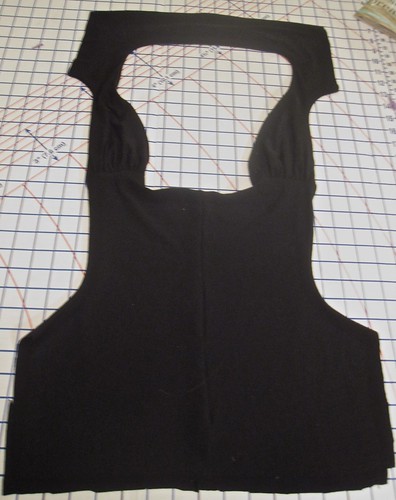
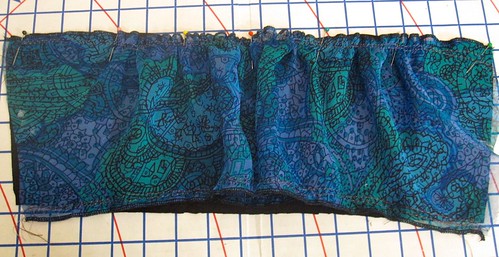
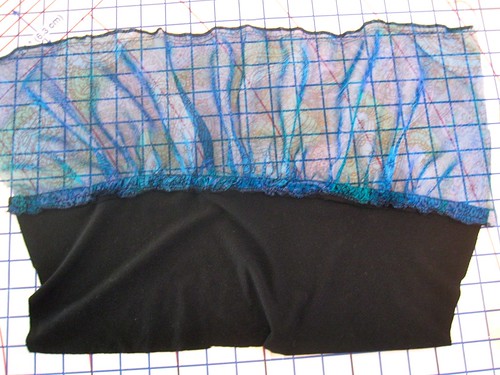
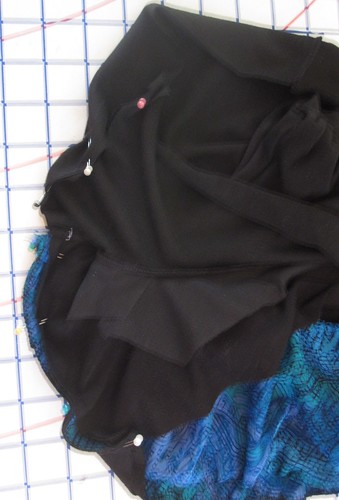

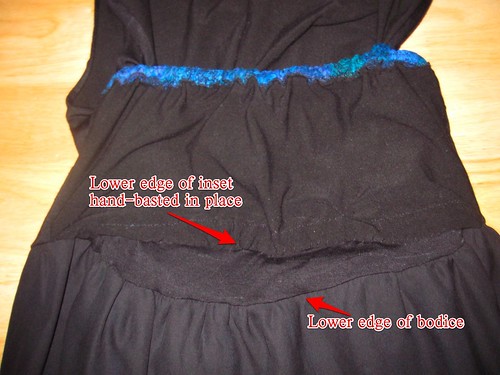



.jpg)








































































.jpg)















